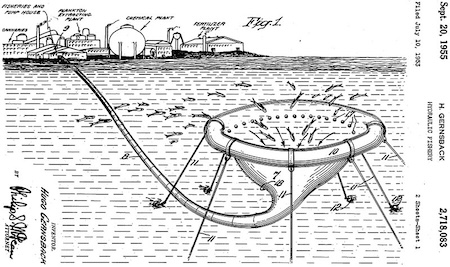Science Fiction
Dictionary
A B C D E F G H I J K L M N O P Q R S T U V W X Y Z
Self-Propelled Underwater Fish Cages

A self-propelled underwater fish cage developed and recently tested by an MIT researcher may provide a way for fish farming to move out onto the open ocean.
(Giant self-propelled fish farm video)
Cliff Goudey, director of MIT Sea Grant's Offshore Aquaculture Engineering Center, is exploring a different approach to moving the cages. By placing large, slow-turning propellers directly on a cage, Goudey frees it from the normal constraints of a boat. His system uses a pair of eight-foot diameter, electrically powered propellers, with 6.2-horsepower underwater motors. The motors are powered through tethers to the surface attached to a diesel generator and a pair of motor controllers mounted on a small boat.Recently he tested the approach at Snapperfarm Inc., an offshore fish farm in Culebra, Puerto Rico, that grows cobia in submerged cages. By fixing a pair of the propellers to the mid-depth of a 62-foot diameter Aquapod® fish cage in a horizontal line 9 feet apart, Goudey maneuvered the cage as well as any boat-based system.
Mobile fish cages could solve a variety of problems related to fish farming in the open ocean. The limiting factor in the number of fish that can be raised in a cage is often the oxygen content of the water during slack water. A moving cage could ensure a steady supply of fresh water.
Fish farming, in the sense of raising fish in a land enclosure for food, has been around for centuries. Mariculture, the raising of fish for food in the open ocean, is only a few decades old.
Update 27-Jan-2024: This is a patent drawing submitted by Hugo Gernsback, not part of a science fiction story, however:

(Hydraulic Fishery patent drawing by Hugo Gernsback in 1953)
End update.
From MIT tests self-propelled cage for fish farming.
Scroll down for more stories in the same category. (Story submitted 9/11/2008)
Follow this kind of news @Technovelgy.| Email | RSS | Blog It | Stumble | del.icio.us | Digg | Reddit |
Would
you like to contribute a story tip?
It's easy:
Get the URL of the story, and the related sf author, and add
it here.
Comment/Join discussion ( 2 )
Related News Stories - (" Biology ")
Black Fungus Blocks Radiation
'You were surrounded by Astrophage most of the time' - Andy Weir, 2021.
Lunar Biorepository Proposed For Cryo-Preservation Of Earth Species
'...there was no one alive who had ever seen them. But they existed in the Life Bank.' - John Varley, 1977.
Let's Make Slaver Sunflowers! Engineering Plants To Reflect Light
'The mirror-blossom was a terrible weapon.' - Larry Niven, 1965.
Machete-Wielding Philodendron Isn't Going To Take It Anymore
'The tree ended its wild larruping, stood like a dreaming giant liable to wake into frenzy at any moment.' - Eric Frank Russell, 1943.
Technovelgy (that's tech-novel-gee!) is devoted to the creative science inventions and ideas of sf authors. Look for the Invention Category that interests you, the Glossary, the Invention Timeline, or see what's New.
Science Fiction
Timeline
1600-1899
1900-1939
1940's 1950's
1960's 1970's
1980's 1990's
2000's 2010's
Current News
The Zapata Air Scooter Would Be Great In A Science Fiction Story
'Betty's slapdash style.'
Thermostabilized Wet Meat Product (NASA Prototype)
There are no orbiting Michelin stars. Yet.
Could Crystal Batteries Generate Power For Centuries?
'Power could be compressed thus into an inch-square cube of what looked like blue-white ice'
India Ponders Always-On Smartphone Location Tracking
'It is necessary... for your own protection.'
Amazon Will Send You Heinlein's Knockdown Cabin
'It's so light that you can set it up in five minutes by yourself...'
Is It Time To Forbid Human Driving?
'Heavy penalties... were to be applied to any one found driving manually-controlled machines.'
Replace The Smartphone With A Connected Edge Node For AI Inference
'Buy a Little Dingbat... electropen, wrist watch, pocketphone, pocket radio, billfold ... all in one.'
Artificial Skin For Robots Is Coming Right Along
'... an elastic, tinted material that had all the feel and appearance of human flesh and epidermis.'
Robot Guard Dog On Duty
I might also be thinking of K-9 from Doctor Who.
Wearable Artificial Fabric Muscles
'It is remarkable that the long leverages of their machines are in most cases actuated by a sort of sham musculature...'
BrainBridge Concept Transplant Of Human Head Proposed
'Briquet’s head seemed to think that to find and attach a new body to her head was as easy as to fit and sew a new dress.'
Google's Nano Banana Pro Presents Handwritten Math Solutions
'...copy was turned out in a charming and entirely feminine handwriting.'
Edible Meat-Like Fungus Like Barbara Hambly's Slunch?
'It was almost unheard of for slunch to spread that fast...'
Sunday Robotics 'Memo' Bot Has Unique Training Glove
'He then started hand movements of definite pattern...'
Woman Marries Computer, Vonnegut's Dream Comes True
'Men are made of protoplasm... Lasts forever.'
Natural Gait With Prosthetic Connected To Nervous System
'The leg was to function, in a way, as a servo-mechanism operated by Larry’s brain...'
